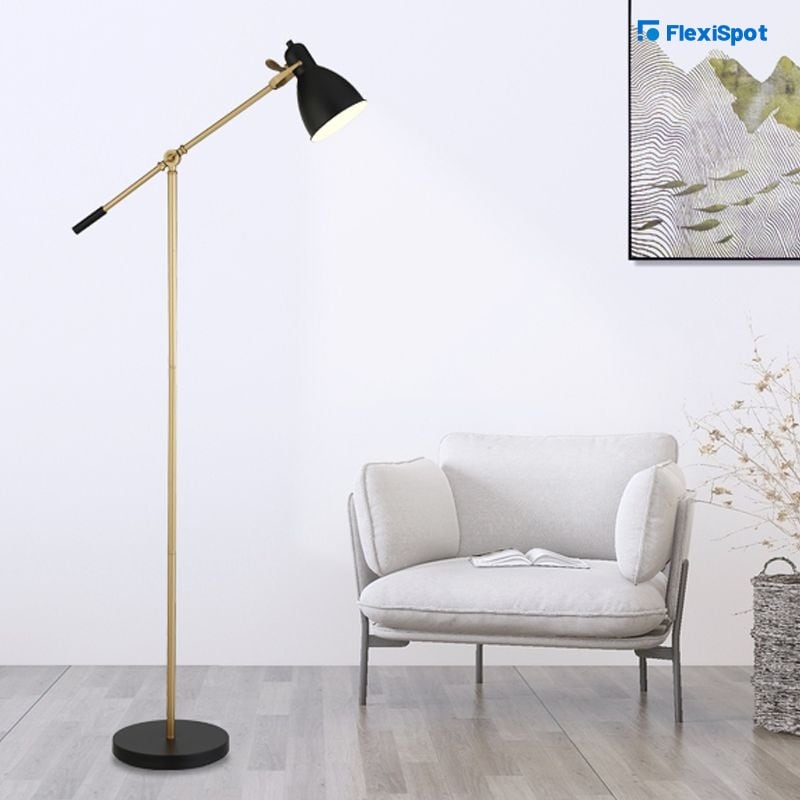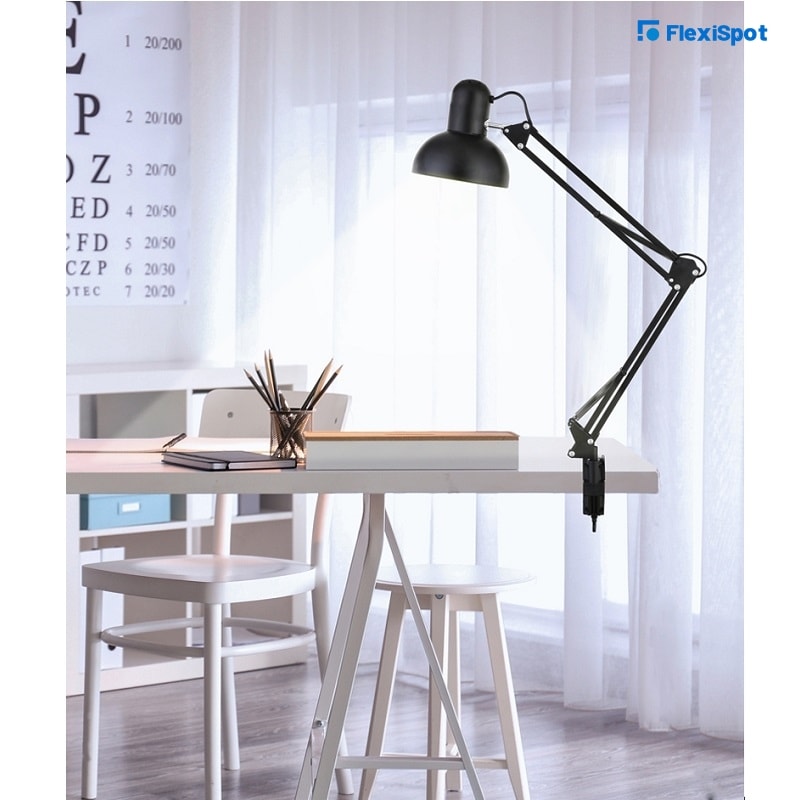Owing to the soaring cases of several work-related medical complications, ergonomic gear, such as ergonomic office chairs, task lighting, etc., in workplaces has become a necessity. This is where items like the FlexiSpot lamps come into the picture, offering the corporate world a convenient solution to a wildly prevalent problem
Ergonomics And Workplaces
Workplace-related injuries due to overexertion are a grave reality within the workforce. A large majority of people working in different industries tend to develop medical conditions for doing repetitive tasks, primarily in wonky postures. These injuries or illnesses are often termed work-related musculoskeletal disorders or WRMSDs.
Despite being a major concern among the employed population worldwide, ailments occurring because of overworking at work continue to affect most people in the corporate sector. Statistics show that private-sector employees took 900,380 DAFW (days away from work) in 2018, out of which 272,780 were due to musculoskeletal disorders or MSDs, approximately 30% of the DAFW cases.
Considering the staggering WRMSD stats, it's safe to say that ergonomically designed products are in need more than ever. And by the looks of things, it seems that this need will only continue to rise.
Therefore markets are now teeming with ergonomic merchandise. Though, not all such products are made the same. Depending on the manufacturers, the quality can vary. However, if you invest in the items like the FlexiSpot Lamps for your office, you can significantly improve employee productivity.
That said, many people often struggle to understand the relation between lighting and medical conditions, warranting task lights. Keeping that in mind, we share everything about task lighting and how it ties into the concept of ergonomics in workplaces.
Task Lighting AKA Focused Lighting
As the name suggests, task lighting refers to a lighting mechanism that provides light to perform a specific task better or more efficiently. In simple words, unlike the ambient lighting in a room or office that illuminates the entire space, focused lighting throws light at a particular workstation to aid the activity in the process.
For instance, let's say an architect has to draw the blueprints of their next project. To do the job more precisely, they use a desk lamp or clip-on light so that they don't make errors in the design. Sure, there must be overhead lighting in the room, but it won't be enough to truly focus on the sheets.
An office lamp, on the other hand, will offer an unmistakably clear look, improving the quality of work while preventing stiffness, soreness, or an injury due to improper posture.
Long story short, task lighting apparatuses, such as the FlexiSpot Lamps, are excellent features to have in a workplace as those help workers perform better without hurting themselves.
Need For Task Lighting In Offices
When working in an office, employees need light to perform a job. However, the requirement of the intensity of light keeps changing with every assignment, and understandably so.
A drawing-based project will require much brighter lighting than a computer-based task. Likewise, the age of employees will also affect their individual illumination needs, which, rationally speaking, shouldn't be managed with the same source.
That's not all. Aside from differing lighting requirements of employees, an office environment must provide direct lighting on workstations because ambient lighting can often lead to glares and shadows.
Consequently, a person's view is compromised, resulting in awkward sitting stances and unsafe neck movements to improve vision. This can eventually lead to musculoskeletal disorders, most common of which are neck and back pain.
To prevent injuries and medical problems caused by poor or ineffective illumination, task lighting is now becoming a must-have feature in workplaces; of course, that's with good reason.
Benefits Of Task Lighting In Workplace Ergonomics
Occupations with ergonomic support mechanisms are known to enhance employee productivity, reduce costs and boost the overall morale in the workplace. Naturally, when workers have the assistance of ergonomically designed products, they not only do their job better but also feel more content and dedicated.
The ergonomic provisions enable employees to work more effortlessly. Moreover, they feel well taken care of, which positively impacts their loyalty towards the employer. And that holds for all ergonomic items, including task lighting.
Here is a deeper look into the benefits of task lighting.
Worker Benefit
During the course of a workday, workers have plenty of distractions (as is )that they must get around in order to complete the daily tasks. They don't need more struggles, such as improper lighting to battle to get work done. Obviously, if that happens and the brightness in the room is too low, or in some cases too high, it will dissuade employees from continuing working, and they most likely will take a break.
Furthermore, when the light in an office isn't enough or causes glares on a screen, a worker has to hunch or crane their neck awkwardly to achieve clear vision, straining the eyes.
Burning or a stinging sensation in the eyes is a common problem among people working desk jobs, particularly the ones involving screens. The continued strain on an individual's retinas will force them to take a quick breather and rest their eyes.
If you are a corporate employee and have to sit in front of a screen all day long, you would know how important resting the eyes can become at times.
With focused lighting, workers don't have to struggle to view documents or screens at the very least. Not to mention their retinas and irises aren't stressed, reducing the straining.
All these contributors lead to enhanced efficiency in the workplace.
Different Employees And Different Eyesights
Like all other senses, eyesight or the ability to see is different for every other person. What someone can see under an overhead light may not be the same for everyone working in the room, which is also why people get glasses.
So, it's fair to say that individuals working in the same office can (and do) have different eyesights, affecting their ability to work. This means some employees may require brighter lighting to view a file while others may be fine with less.
Therefore, having ambient lights can never be enough to achieve optimal productivity levels in the workplace, which is why task lighting is imperative.
Aside from the naturally occurring difference in eyesight, the age of employees impacts how well they see something.
Young workers in their 20s are believed to see 8 times better than those in their 60s due to the change in the flexibility of eye muscles.
Our irises are responsible for letting light into our eyes, making it possible for us to view anything. But with age, their functionality declines, and they become a bit stiffer, resulting in slower reflex timings. That is, as we grow old, the iris muscles lose their sharpness and start taking a lot longer to open and shut, affecting our eyesight.
Therefore, different aged people require different lighting intensities to see things. This means you cannot expect a 60-year-old worker to see a file or screen in the same light as a 20-year-old, making task light incredibly useful for a workplace.
Having focused lighting allows all employees to perform their very best, at least as far as the light-based hindrances to their performance are concerned, which leads to overall higher efficiency.
Control On Intensity
Perhaps the most appealing perk of task lighting is the control users have over the illumination power. With the regulators embedded indirect light systems, individuals get to adjust the light intensity according to their needs. This not only helps them work better but also allows them to relax a little if they wish to put their head down for a bit without any light in their face.
Besides the regulatory control, task lighting allows the user to angle a light source however they want with the adjustable arm. Most office lamps, such as the FlexiSpot Lamps, come with a rotatable, movable rod/coil that enables workers to set the light in whichever direction they want. This option is incredible for those who require dexterity to perform their job.
To put it simply, if someone has to construct something or illustrate something, they might require direct lighting on specific points in their workspace, which becomes possible with task lights.
Long story short, the superior control over workplace illumination that focused lighting gives users makes such fixtures much more desirable.
Better Magnification
Do you wear glasses? If not, then ask anyone who does, and they'll tell you that glasses are rather useless if there isn't proper light to reflect from an object to make it visible. That is why if someone uses spectacles, they will need supplementary light to view anything.
Therefore, task lighting is essential for workplaces as it enables people with weak eyesight to focus correctly and not struggle to examine/look through something.
Ending Note
Task lighting is undoubtedly a must-have system in any workplace, even a home office or study environment, to improve productivity by providing the user a clear vision.
If you haven't already invested in top-grade focused lights, it's time you do so to be more efficient in doing every activity, be it work-related or household-related.



